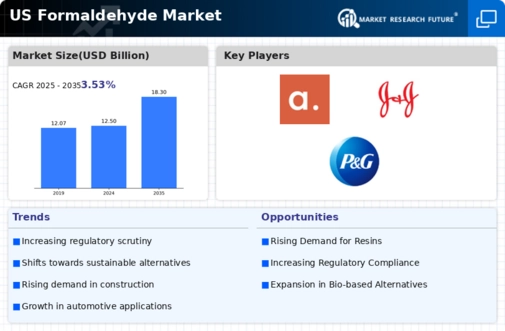The formaldehyde market exhibits a complex competitive landscape characterized by a blend of established players and emerging innovators. Key growth drivers include increasing demand from the construction and automotive sectors, alongside a heightened focus on sustainability and regulatory compliance. Major companies such as BASF SE (DE), Hexion Inc. (US), and Georgia-Pacific LLC (US) are strategically positioned to leverage these trends. BASF SE (DE) emphasizes innovation in product development, particularly in bio-based formaldehyde solutions, while Hexion Inc. (US) focuses on expanding its portfolio through strategic acquisitions. Georgia-Pacific LLC (US) is enhancing its operational efficiency through digital transformation initiatives, collectively shaping a competitive environment that prioritizes sustainability and technological advancement.
In terms of business tactics, companies are increasingly localizing manufacturing to reduce supply chain vulnerabilities and optimize logistics. The market structure appears moderately fragmented, with a few dominant players exerting considerable influence. This fragmentation allows for niche players to thrive, yet the collective strategies of key companies drive a competitive dynamic that emphasizes innovation and responsiveness to market demands.
In November 2025, Hexion Inc. (US) announced the acquisition of a regional competitor, which is expected to enhance its market share and operational capabilities. This strategic move underscores Hexion's commitment to expanding its footprint in the formaldehyde sector, potentially allowing for greater economies of scale and improved product offerings. The acquisition may also facilitate access to new customer segments, thereby reinforcing Hexion's competitive position.
In October 2025, BASF SE (DE) launched a new line of eco-friendly formaldehyde products aimed at reducing environmental impact. This initiative aligns with global sustainability trends and positions BASF as a leader in environmentally responsible manufacturing. The introduction of these products could attract environmentally conscious consumers and businesses, further differentiating BASF in a competitive market.
In September 2025, Georgia-Pacific LLC (US) implemented advanced digital tools in its production processes, enhancing efficiency and reducing waste. This digital transformation is likely to improve operational performance and cost-effectiveness, allowing Georgia-Pacific to respond more swiftly to market changes. Such initiatives reflect a broader trend within the industry towards integrating technology to optimize production and supply chain management.
As of December 2025, current competitive trends indicate a strong shift towards digitalization, sustainability, and the integration of AI technologies. Strategic alliances are increasingly shaping the landscape, enabling companies to pool resources and expertise. The competitive differentiation is likely to evolve from traditional price-based competition to a focus on innovation, technological advancement, and supply chain reliability. Companies that can effectively navigate these trends will likely secure a competitive edge in the formaldehyde market.














Leave a Comment